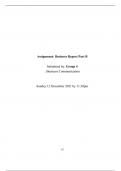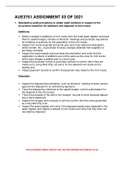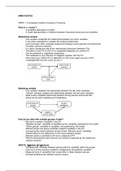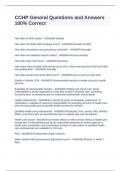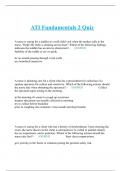Full Name Ogundipe O.T
Student no. 55455921
Module IOP3708 – Investor Psychology
Assignment 1
Specific outcome 1
Question 1
a) 1. Prospect is a probability distribution of wealth outcomes. It is formally described as a series
ofoutcomes, that each is associated with a probability as (Ackert & Deaves 2010 :7) stated.
Prospect in economics terms refers to a series of wealth outcomes or advancements in profits
which are associated with a certain probability. To which the probability in this case is the
likelihood that something may or may not occur.
WHILE
2. Probability distribution is the likelihood of the possible outcomes. The Probability concept is
alsoused to measure the risk. Siegumund once pointed out that this probability as a concept is also
known as a relative frequency that easy games involving coins, dice etc. are a good example. Even
though the collective results of large number of trials reflects some regularity, these are the games
1.1
of chance whose outcome of a given trial cannot be predicted with certainty. Statistically,
probability distribution refers to the allocation of those wealth outcomes that is then linked to each
outcome therefore indicating the probabilities linked from lowest to highest expected values from
which the investor can chose from.
b) 1. Utility function: is used so that the preferred choices receive the higher number after the
numbersare assigned to the outcomes. Utility is the satisfaction derived from outcome from any act
that could possibly happen (Ackert & Deaves, 2010: [P4]). A good example can be made of
customers atthe store when the opt to buy a particular product or a bundle of goods over another.
For an example, a customer chooses 4 apples over 3 oranges or chooses 4 oranges over 3 apples. In
this concept, preference is key. Utility function in this case refers to identification of preference to
potential outcomes according to the expected returns that will bring about satisfaction to the
Page 1 of 15
, investor. Utility measures to size of the cash flow or wealth outcome linked to their probabilities
from least desired to the most preferred from the distribution list or table where investors can make
their choices relative to the available probabilities. The significant function of utility is to also
reveal the risk preferences from several options of probabilities available
WHILE
2. Expected utility: This is a term that is mostly used in economics that measures what is
somethingis worth to a person, usually a product or a commodity. It summarizes the utility that an
aggregate economy is expected to reach under any number of circumstances.
c) 1. Risk aversion: is mostly used in the field of finance to classify the types of investors and their
behaviour. In the case of investment projects and investor is said to be risk averse if is not willing to
invest in a project that is identified as risky, usually these types of investors opt to invest in a less
risky project to almost guarantee his or her returns. Risk aversion refers to the type of investors are
reluctant to take risk or avoid it altogether usually in a case whereby they have two or more options
of investments. In this case these investors prefer lower returns with a degree of certainty that a
higher return associated with uncertainty. Risk aversion refers to the type of investors are reluctant
to take risk or avoid it altogether usually in a case whereby they have two or more options of
investments. These types of investors always settle for the asset with a lower risk with rather
guaranteed returns even if it means they are relatively low than choosing a high risk investment
linked to uncertainty.
WHILE
2. Risk seeking: This term is used to identify investors that are willing to invest in high-risk project
investment or investments. Their expectation is to be compensated with higher returns hence the
are willing to take a big risk in a sense that, if their investments do not yield those higher expected
return, they yield a big loss. Risk seekers are investors who are always in search for investments
that are volatile in nature or behaviour and usually associated with uncertainly with the risk of
higher gains or losses. In the investment world, risk seekers usually gambling behaviour and are
not terrified by risk
WHILE
3. Risk neutrality: These types of investors are said to be lying between risk averse and risk seeker
ones. To them the risk does not matter at all, they only pay attention to the expected values as
Ackert & Deaves wrote about it (2010:10). These are indifferent type of investors to risk, making
them to be in-between the risk averse and seeking. Their main focus is on the expected value of an
asset and they are not bothered by the risk it is associated with. Their choice of investments is not
determined by the level of uncertainty involved.
Page 2 of 15
, Question 1.2
a) Systematic risk refers to the situation where all firms are affected by general economic conditions
such as inflation, political, fiscal, and monetary impact. These types of risks remain whether the
portfolio is formed or not, it is unavoidable. Systematic risk, which is also referred to as market
3.1
risk or un-diversifiable risk is the type of uncertainty that is inherited because of the market
environment in which they exist. Types of assets under this environment often have behaviour of
day-to-day fluctuations that may change the direction of the investment to whether the expected
return it will exceed or fall short. Uncontrollable factors such as interest rates, changes in the
economy will always impact on the stock market.
Whereas
Non-systemic risk is known as diversifiable risk. It is mostly associated with events that affect
individual companies, such as the implementation of company strategies like new product
development, market development or evendiversifying by inventing locally or regionally. To
effectively deal with this type of situation the portfolios must be diversified so that negative vents
affecting one firm maybe offset by positive results from other portfolios, Marx, Mpofu, De Beer,
Mynhardt and Nortje wrote (2017; 9). Unsystematic risk which is also well-known to as specific
risk or residual risk refers to the nature of uncertainty that is inherent by the environment of the
industry one invests in. The advantage about the unsystematic risk is that trends that are within the
industrial environment in which may exist can be mitigated, for example, interruptions like
boycotts that bring uncertainty into companies one has invested in pose a risk to assets.
b) Beta is a measure of systematic risk of portfolio when it is compared to the whole market. It is
mostly used to describe the relationship between systematic risk and the expected return for assets
in the capital asset pricing model, (Westfall: 2021). Beta in terms of the financial market is a tool
that measures risk of the market as a whole. In other words the beta measure the unpredictability
referred to as volatility in financial terms in the entire market,
Whereas
Standard deviation is a measure of total risk. Its main use is to check how closely the
probability distribution is centred around the expected value. If the spread of the distribution is
bigger, therefore it indicates that the standard deviation is bigger, Marx, Mpofu, De Beer,
Mynhardt and Nortje wrote (2017; 14). This is the measure used by investor to see how risky the
project is for them to take a decision to invest. On the other hand, the standard deviation is a tool
that is used to measure the risk for individual or a specific stock in the market. The standard
Page 3 of 15
Student no. 55455921
Module IOP3708 – Investor Psychology
Assignment 1
Specific outcome 1
Question 1
a) 1. Prospect is a probability distribution of wealth outcomes. It is formally described as a series
ofoutcomes, that each is associated with a probability as (Ackert & Deaves 2010 :7) stated.
Prospect in economics terms refers to a series of wealth outcomes or advancements in profits
which are associated with a certain probability. To which the probability in this case is the
likelihood that something may or may not occur.
WHILE
2. Probability distribution is the likelihood of the possible outcomes. The Probability concept is
alsoused to measure the risk. Siegumund once pointed out that this probability as a concept is also
known as a relative frequency that easy games involving coins, dice etc. are a good example. Even
though the collective results of large number of trials reflects some regularity, these are the games
1.1
of chance whose outcome of a given trial cannot be predicted with certainty. Statistically,
probability distribution refers to the allocation of those wealth outcomes that is then linked to each
outcome therefore indicating the probabilities linked from lowest to highest expected values from
which the investor can chose from.
b) 1. Utility function: is used so that the preferred choices receive the higher number after the
numbersare assigned to the outcomes. Utility is the satisfaction derived from outcome from any act
that could possibly happen (Ackert & Deaves, 2010: [P4]). A good example can be made of
customers atthe store when the opt to buy a particular product or a bundle of goods over another.
For an example, a customer chooses 4 apples over 3 oranges or chooses 4 oranges over 3 apples. In
this concept, preference is key. Utility function in this case refers to identification of preference to
potential outcomes according to the expected returns that will bring about satisfaction to the
Page 1 of 15
, investor. Utility measures to size of the cash flow or wealth outcome linked to their probabilities
from least desired to the most preferred from the distribution list or table where investors can make
their choices relative to the available probabilities. The significant function of utility is to also
reveal the risk preferences from several options of probabilities available
WHILE
2. Expected utility: This is a term that is mostly used in economics that measures what is
somethingis worth to a person, usually a product or a commodity. It summarizes the utility that an
aggregate economy is expected to reach under any number of circumstances.
c) 1. Risk aversion: is mostly used in the field of finance to classify the types of investors and their
behaviour. In the case of investment projects and investor is said to be risk averse if is not willing to
invest in a project that is identified as risky, usually these types of investors opt to invest in a less
risky project to almost guarantee his or her returns. Risk aversion refers to the type of investors are
reluctant to take risk or avoid it altogether usually in a case whereby they have two or more options
of investments. In this case these investors prefer lower returns with a degree of certainty that a
higher return associated with uncertainty. Risk aversion refers to the type of investors are reluctant
to take risk or avoid it altogether usually in a case whereby they have two or more options of
investments. These types of investors always settle for the asset with a lower risk with rather
guaranteed returns even if it means they are relatively low than choosing a high risk investment
linked to uncertainty.
WHILE
2. Risk seeking: This term is used to identify investors that are willing to invest in high-risk project
investment or investments. Their expectation is to be compensated with higher returns hence the
are willing to take a big risk in a sense that, if their investments do not yield those higher expected
return, they yield a big loss. Risk seekers are investors who are always in search for investments
that are volatile in nature or behaviour and usually associated with uncertainly with the risk of
higher gains or losses. In the investment world, risk seekers usually gambling behaviour and are
not terrified by risk
WHILE
3. Risk neutrality: These types of investors are said to be lying between risk averse and risk seeker
ones. To them the risk does not matter at all, they only pay attention to the expected values as
Ackert & Deaves wrote about it (2010:10). These are indifferent type of investors to risk, making
them to be in-between the risk averse and seeking. Their main focus is on the expected value of an
asset and they are not bothered by the risk it is associated with. Their choice of investments is not
determined by the level of uncertainty involved.
Page 2 of 15
, Question 1.2
a) Systematic risk refers to the situation where all firms are affected by general economic conditions
such as inflation, political, fiscal, and monetary impact. These types of risks remain whether the
portfolio is formed or not, it is unavoidable. Systematic risk, which is also referred to as market
3.1
risk or un-diversifiable risk is the type of uncertainty that is inherited because of the market
environment in which they exist. Types of assets under this environment often have behaviour of
day-to-day fluctuations that may change the direction of the investment to whether the expected
return it will exceed or fall short. Uncontrollable factors such as interest rates, changes in the
economy will always impact on the stock market.
Whereas
Non-systemic risk is known as diversifiable risk. It is mostly associated with events that affect
individual companies, such as the implementation of company strategies like new product
development, market development or evendiversifying by inventing locally or regionally. To
effectively deal with this type of situation the portfolios must be diversified so that negative vents
affecting one firm maybe offset by positive results from other portfolios, Marx, Mpofu, De Beer,
Mynhardt and Nortje wrote (2017; 9). Unsystematic risk which is also well-known to as specific
risk or residual risk refers to the nature of uncertainty that is inherent by the environment of the
industry one invests in. The advantage about the unsystematic risk is that trends that are within the
industrial environment in which may exist can be mitigated, for example, interruptions like
boycotts that bring uncertainty into companies one has invested in pose a risk to assets.
b) Beta is a measure of systematic risk of portfolio when it is compared to the whole market. It is
mostly used to describe the relationship between systematic risk and the expected return for assets
in the capital asset pricing model, (Westfall: 2021). Beta in terms of the financial market is a tool
that measures risk of the market as a whole. In other words the beta measure the unpredictability
referred to as volatility in financial terms in the entire market,
Whereas
Standard deviation is a measure of total risk. Its main use is to check how closely the
probability distribution is centred around the expected value. If the spread of the distribution is
bigger, therefore it indicates that the standard deviation is bigger, Marx, Mpofu, De Beer,
Mynhardt and Nortje wrote (2017; 14). This is the measure used by investor to see how risky the
project is for them to take a decision to invest. On the other hand, the standard deviation is a tool
that is used to measure the risk for individual or a specific stock in the market. The standard
Page 3 of 15




